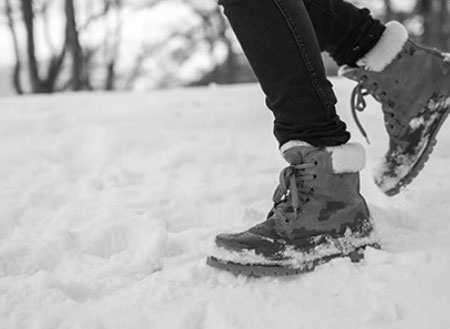
Oh, Mother Nature. How she graces us with her presence. Amongst the dazzling icicles and picture-perfect snow are large sheets of the most slippery ice I have ever experienced that is wreaking havoc on the young and old and strong and frail alike. No one is immune to her ornery shenanigans. We have had a heck of a week here at Orthopaedic Associates of Wisconsin trying to evaluate and appropriately treat all of the fractures that have come through our doors. One of our upper extremity specialists saw FIFTEEN wrist fractures in clinic one day, so please bear with us if we seem a little frazzled!
We can see the light at the end of the tunnel, but we suspect that we are not finished seeing all of the fractures just yet as the weather forecast shows warm, snow-melting temperatures on the horizon followed by single digits that will certainly freeze whatever snow has started to melt. .
Though not entirely preventable, steps can be taken to improve one’s chances of walking away from a slip on the ice scathe-free. With conditions such as what we have been experiencing, assume that any patch of sidewalk cleared of snow is covered in a thin layer of ice. It doesn’t matter if ice is two inches thick or a fraction of an inch thick. Ice is ice and ice is slippery. Walking on ice requires a slightly different gait pattern from our normal every day walking. We must channel our inner penguin to improve our chances of staying on our feet. Turning your feet outward slightly while taking small steps or shuffling can help maintain some traction on slippery surfaces. You should shuffle with your knees bent slightly and your center of gravity over the balls of your feet. Keeping your hands out of your pockets with your arms extended out to your sides can further improve your balance and ability to accommodate the slippery surface. Appropriate foot attire to include soles with non-slip rubber or neoprene with grooves will help keep you upright as well.
If these strategies don’t keep you upright, your goal is to avoid sticking out one or both of your arms to brace your fall. Though instinctual, bracing your fall actually increases your chances of sustaining a fracture to your upper extremity. Tucking and rolling is a safer option. DISCLAIMER, you should make every attempt to protect your head. If that means sustaining a wrist fracture, it is most certainly the lesser of two evils. Even if the weather is not frigidly cold, wearing extra layers of clothing can help pad your fall. Use handrails and handles wherever available.
The easiest way to prevent winter-related injuries is to hibernate, but we fully understand that sitting at home all winter is not the Wisconsin way. If you have recently had surgery with one of our board-certified surgeons, we would recommend that you protect yourself and your surgical site, and stay inside. If you use an ambulatory aid such as a cane, crutches, a walker, or a knee scooter, you should refrain from being out in slippery conditions as well.
If Mother Nature prevails and sends you slipping and sliding to the ground, give us a call. We are here to take x-rays, evaluate, and treat whatever injuries you bring us. Schedule an appointment or utilize our Ortho ASAP clinic available Monday through Thursday from
8:00AM-8:00PM, Friday from 8:00AM-5:00PM, and Saturdays from 9:00AM-Noon.
This blog is written by one of our very own-Morgan. She is a certified athletic trainer working as a medical assistant with our providers each and every day in our clinic. She obtained a bachelor's degree in athletic training from Carroll University in Waukesha and a master's degree in Kinesiology from Michigan State University. She is excited to bring you updates and information about the happenings at OAW.

